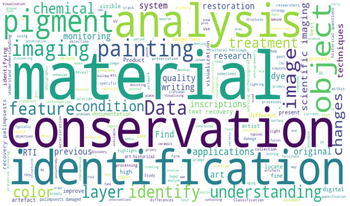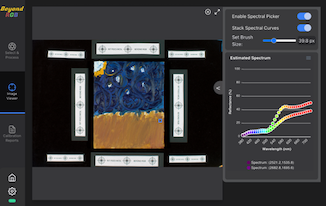
This work presents insights into the imaging workflow from cultural heritage domain experts, gathered from an online survey. Non-invasive 2D imaging technology has become a cornerstone in the analysis and documentation of cultural heritage artefacts. Techniques such as hyperspectral imaging (HSI) and X-ray fluorescence (XRF) can investigate material properties, artistic processes, and conservation states. Existing analysis and visualisation tools offer functionality for specific data types but lack integration for holistic multimodal analysis. To address these limitations, we conducted a structured survey targeting researchers and practitioners in CH working with imaging technology. The survey explores their workflows, imaging technology usage, and software preferences. This study identifies key trends, challenges, and feature requirements.

libvips is a LGPL licensed (open source and free for commercial use), portable, horizontally-threaded, demand-driven, 2D image processing library with its origins in imaging research projects. Compared to similar libraries, libvips runs quickly and uses little memory. It supports numeric formats from 8-bit integer to 128-bit complex, any number of color separation bands, most popular image formats, and many specialized scientific image formats. It has become popular in applications such as virtual microscopy and art imaging, and very popular as an image processing library for the web. This paper outlines the history of the library, explains how libvips achieves its good performance, presents benchmarks, and gives an overview of the implementation and of the wider libvips ecosystem.

Beyond RGB is a free, opensource, software application providing colorimetric and spectral processing of a 6-channel spectral image. The software has an input of two sets of RAW RGB images, one set for each of two different lighting conditions. These sets include a dark current, flatfield, target, and item. The outputs are an RGB image that is color calibrated with data on the accuracy of the calibration and user-selected spectral reflectance estimations of regions of interest. The improvements created for this version of the software include an updated user interface, auto-sorting of files, improved color difference calculation and visualization, a userfriendly website, and the inclusion of various RAW file types.

This paper presents an abbreviated summary of previous work using a distributed emulation network (EaaSI) to allow for the analysis of computer assisted design (CAD) tools including multiple versions of the popular AutoCAD system. It elaborates on the use of EaaSI in a graduate seminar on the history of computational design, presenting a design pedagogy use case for archived software objects and showing how their remediation through emulation can lead to new historical and design insights into contemporary software. It includes further clarification on the relevance of emulation to the archival community and highlights extended use cases not found in the original publication.